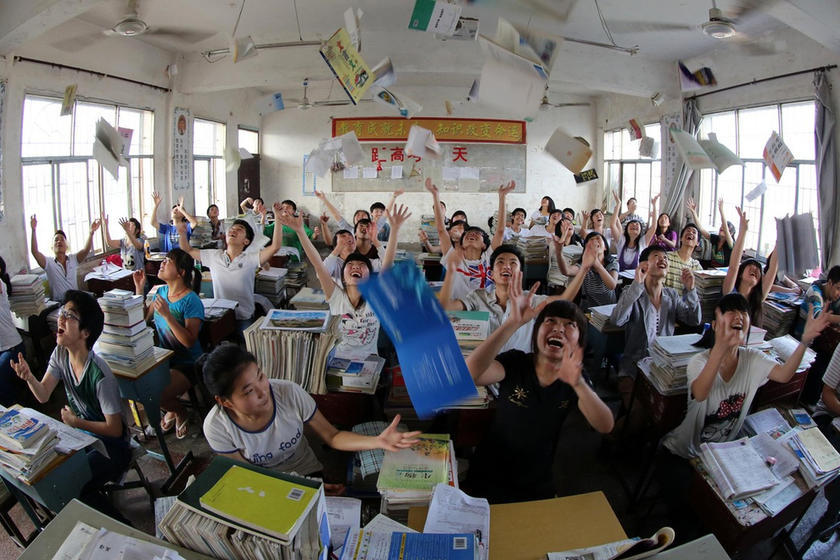
Anti-Privilege Campaign Hits the Chinese Middle Class
Publication: China Brief Volume: 14 Issue: 17
By:

On September 4, China’s State Council announced a series of ambitious and wide-reaching reforms of the Chinese college admissions system, designed to increase fairness and reduce pressure on China’s high school students. China’s infamous college admissions test, the gaokao, will be restructured, replacing a single high-pressure examination at the end of senior year with a series of tests spread out over the three years of high school (State Council, September 4). The reforms are focused on increasing equality and fairness by allocating more spaces to underrepresented students from rural areas and inland provinces. This reform is likely to be the most public-facing component of a wide-ranging effort by the Xi Jinping administration to address perceptions of elite privilege and social inequality. Yet, the reforms face challenges from an entrenched system and eager middle-class parents who will resist changes to the redistribution of opportunities for advancement.
The reforms follow years of experimentation with smaller policy changes that have allowed elite universities to develop their own admissions policies (zizhu zhaosheng), enabling some students to bypass the gaokao entirely. Some of these policies, especially preferential admissions for students deemed to have special athletic and artistic abilities, have been perceived as corrupt and will be reined in by the new reforms. Past high-profile cases include parents buying certificates for sports talent—40,000 RMB ($6,500) for soccer, 80,000 RMB ($13,000) for swimming—and a Party member who falsely registered his son as a member of an ethnic minority, in order to take advantage of affirmative action policies (Sohu, July 3; Xinhua, July 30, 2009)
As the main avenue for social advancement in China, college admissions are the subject of intense attention by high school students and concerned parents. Extremely low acceptance rates, coupled with the fact that spaces at elite universities are allocated based on provincial quotas and favor locals, mean that parents frequently begin strategizing for their children’s education before they are born. News about test scores required for elite universities and details of the annual gaokao frequently appear on the front pages of Chinese newspapers. So unequal is this system that one Chinese commentator calculated a student from Beijing is approximately 41 times more likely to enter Peking University, China’s top school, compared to a student from the densely-populated and inland Anhui province (Taipei Times, July 4, 2012). This represents a roughly 0.01 percent acceptance rate for Anhui students, far below Harvard University’s 5.9 percent acceptance rate for 2014.
A Fairness Agenda?
Chinese President Xi Jinping has devoted much of his term to the threat posed by such forms of basic unfairness to the Chinese Communist Party’s (CCP) legitimacy, launching a series of political campaigns to curtail the privileges of Party insiders. In addition to a wide-ranging wave of corruption arrests, he has lectured cadres about flaunting signs of wealth, limiting the use of official cars, forbidding banqueting and discouraging expensive presents. Xi also repeatedly reminds cadres that the survival of the Party depends upon their maintaining good “work styles” (see China Brief, August 23, 2013). This week, the rule against presents has resulted in remarkably low sales of mooncakes—down 50 percent in some cities—during the Mid-Autumn Festival (China Daily, September 5). The education reforms have a thematic connection to the issue of fairness. However, unlike Xi’s political campaigns, they will directly affect non-Party members and have been announced by a state body.
The State Council document and official commentaries published in People’s Daily and China Youth Daily heavily emphasize fairness, equality and public justice as the main goals of the reform (People’s Daily, September 5; China Youth Daily, September 5). The document stresses the government’s responsiveness to public concerns, referring to “issues that elicit a strong reaction from society,” and seeks to “make education satisfactory for the people.” The document also touts a “sunshine project,” promising to increase transparency “to release everything that can be released,” and specifically mentions providing more information about high-profile disciplinary actions and application procedures.
The State Council document sets two overarching targets: First, narrowing the gap between admissions of rural and urban students to all universities, and second, addressing the larger inequalities in admissions to elite universities. To accomplish these goals, the document calls for the following reforms:
- Universities, especially universities on China’s east coast, will improve the admissions rates for students from inland and western provinces, as well as minority autonomous regions, currently the most disadvantaged in the admissions system. This will also reduce preferential treatment for local students. By 2017, the State Council aims to reduce the overall gap between the provinces with the lowest admissions rates compared to the national average from the current 6 percent (76 percent versus 70 percent of applicants) to 4 percent.
- Elite universities will establish quotas for exceptional students from rural, poor and ethnic minority areas. No specific targets have been announced, only a desire for a “noticeable increase.”
- The document also calls for improving the provision of primary and secondary education to the children of migrant laborers, but does not provide any specifics.
- In addition, special admissions policies will be severely curtailed, but not fully eliminated. Affirmative action for minority students will be retained, but separate admissions tracks for students certified as talented athletes or artists will be eliminated and all students will be required to take the gaokao.
People’s Daily stated the reform was a “difficult balance between fairness and objectivity [kexue]” and specifies that the reforms are a response to public dissatisfaction, but allows that the reforms will not please everyone and will “touch upon the interests of every family” (People’s Daily, September 5).
Other Goals
While fairness (gongping) is clearly the main focus—mentioned seven times in the document—it also promises to reduce pressure on students and ties the goal to Xi Jinping’s marquee “China Dream” by stressing the role of human capital in “the great revival of the Chinese people.”
The reforms are also intended to improve the overall health of the student by reducing pressure and ensuring a well-rounded education. The document refers to the current system as “a single test that determines one’s whole life” and alludes to the excessive competitive pressure. These measures include spreading out the required exams for college admissions to three years and allowing students to choose three of their six test subjects. While not described in the main document, Vice Minister of Education Liu Limin was quoted on China Radio suggesting that colleges may begin considering students’ moral character (pinde) and extracurricular activities in addition to “ice-cold scores” (China Radio, September 7). In addition to relieving pressure on students by not focusing entirely on gaokao scores, this also injects a subjective assessment of students’ personal activities into the college admissions process, which could yet again allow for corruption. Furthermore, if implemented, this would certainly benefit most those students who participate in the Communist Youth League or other state-approved organizations.
Murky Politics
The politics of this reform are quite mysterious—no senior leaders appear to have taken ownership of the policy or have been mentioned in news coverage. However, the emphasis on fairness and reducing perceptions of privilege reflect Xi’s agenda. On the other hand, the emphasis on rural-urban and coastal-inland inequality suggests ties to former president Hu Jintao’s legacy of “harmonious society.” The most conspicuous absence among senior leaders is Premier Li Keqiang, who is associated with Hu’s faction and leads the State Council. He played a highly public role in the rollout of a large-scale State Council urbanization policy last year, and it is unclear why his name would not be attached to this one (see China Brief, September 27, 2013).
While this reform, if successful, could certainly address a major source of resentment in Chinese society, gains for rural and poor students will necessarily come at a cost for middle class families from major cities. College admissions are a zero-sum game. However, the elite and privileged members of the Party will likely remain relatively unaffected, as they will either continue to influence college admissions through more direct avenues or simply send their children abroad, like Xi’s daughter, who attended Harvard for part of her college education.





